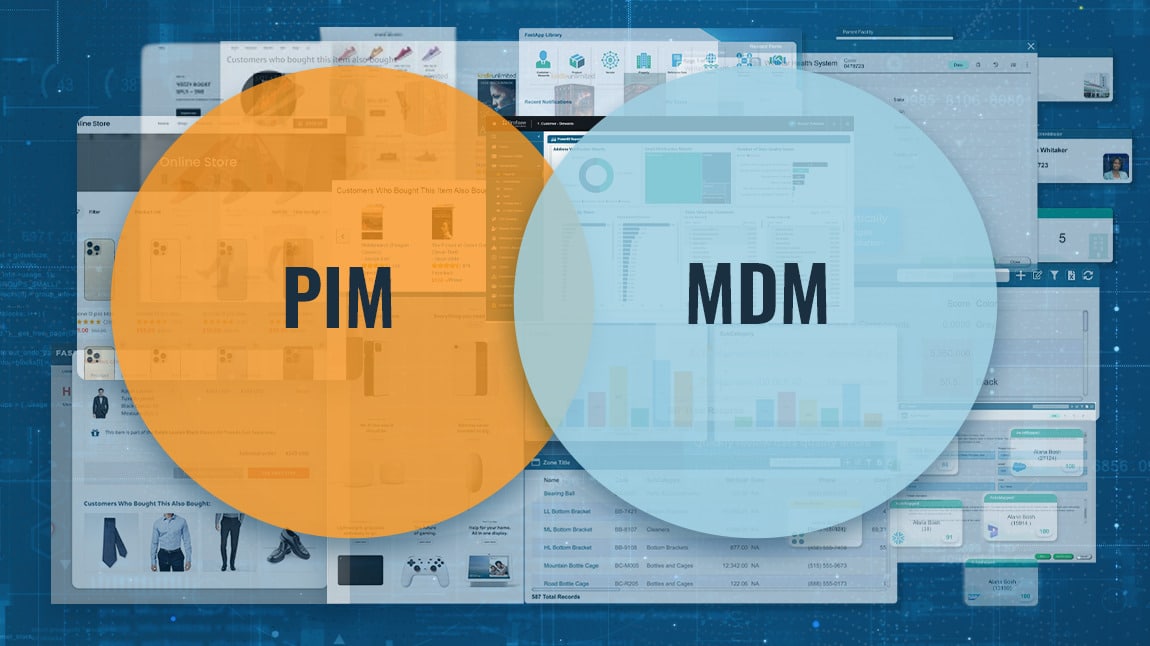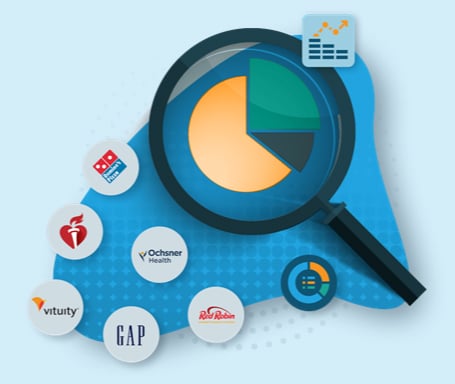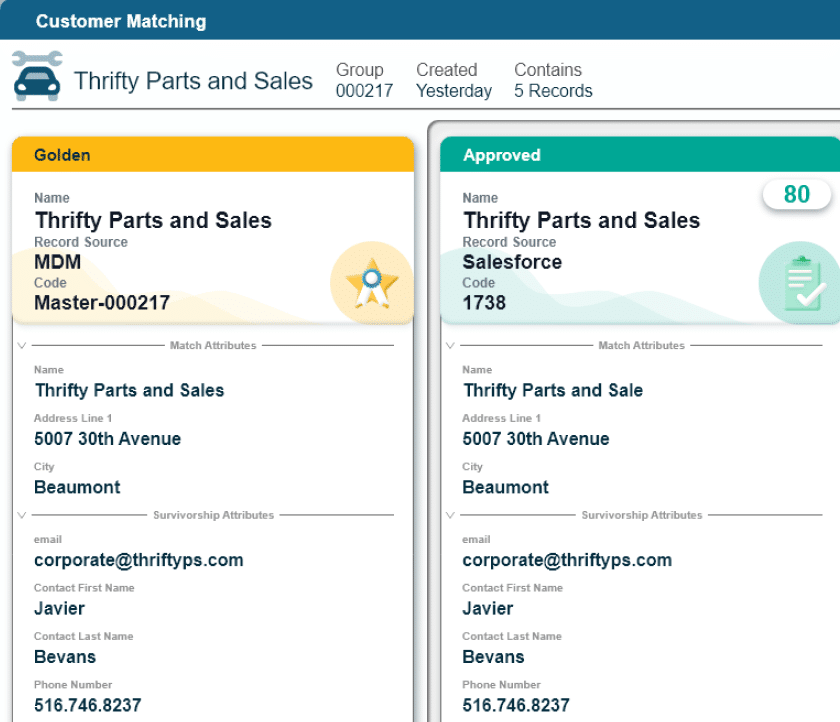Master Data Management (MDM) for Retail
Weave a seamless, highly personalized customer experience and effectively manage your retail operations with Profisee Master Data Management.






Delight Your Customers with Experiences as Easy as they Are Unforgettable
With Profisee for retail master data management, it’s easy to tackle big issues for your retail business so that customers don’t have to sweat the small stuff.
Understand complex product hierarchies:
Accurately forecast customer demand for core products regardless of the channel, packaging or retail SKU.
Drive customer loyalty:
Access to timely, accurate and consistent customer data in one place means better product recommendations, customer loyalty programs, fewer returns and a more positive brand perception for your retail business.
Simplify inventory management:
Don’t let low inventory catch you off guard. With Profisee multidomain MDM for retail and location data management, it’s easy to get the full picture of your product data across stores, warehouses and e-commerce.
Reduce CX load:
Better customer service starts with better data. Reduce support cases stemming from mis-shipments, return difficulties, price discrepancies and inconsistent sales channel experiences.
Improve sales forecasting:
Track thousands of SKUs across all your source systems to identify which products are selling, when — and which ones aren’t.
Streamline supplier relationships:
Take the pain out of supply chain management with powerful 360-degree views of your suppliers to help you better navigate even the most complex supply chains.
Retail Master Data Management Use Cases
Customer
“How can I use my in-store customer data to drive online sales?”
How Profisee Helps
In-store, online, smart speaker or through the app — no matter where your customers prefer to shop, Profisee lets you integrate customer data from different sources to better understand customer preferences and behavior.
Product Design
“How can I use sales data to design more products that our customers will love?”
How Profisee Helps
Get a unified view of sales data across your full customer GTM to identify trends in what customers are purchasing based on location, sales channel, seasonality, material and style.
Marketing & Sales
“How can I forecast sales more accurately and create more targeted marketing campaigns?”
How Profisee Helps
With access to up-to-date, trustworthy data on when, where and how your customers prefer to shop, Profisee makes it easy to anticipate seasonal sales fluctuations and intimately understand what your customers really want.
Fulfillment
“How can I make sure that we have the in-store inventory for customers who order online pickup or delivery?”
How Profisee Helps
Integrated data from all your brick-and-mortar retail locations, warehouses and suppliers makes for a single source of truth for your inventory, helping customers find what they need, where and preventing awkward situations when ordered items are out of stock.
Resources for Retail Companies

Retailers: Survive and Thrive in the Age of Acceleration
Learn More
PIM vs. MDM: Which Is Right For Your Organization?
Learn More
Domino’s: Streamlining Operations with MDM
Learn More
Gap: Improving Customer Experience through MDM
Learn More
Vista Outdoor: Streamlining Product Management with MDM
Learn MoreRetail MDM Frequently Asked Questions
What is retail MDM?
In a retail context, master data management refers to the different data domains commonly used by retail businesses, like product, location and customer data. Different information systems such as point of sale (POS), ERP, marketing automation and CRM generate and store vast amounts of data that tend to live in silos, limiting its usefulness and value to the business.
In addition to being siloed, this data is also often inconsistent, incomplete, duplicated or inaccurate, especially when a business uses several different systems for a given function. A master data management solution like Profisee addresses these pain points by integrating data from disparate systems — be it from multiple CRM or ERP systems or between inventory and POS systems. Profisee then matches related records, merges them, removes duplicate records and standardizes them according to the organization’s data governance policies.
What are the components of retail MDM?
Retail MDM works with the same basic components as other industries but with a few areas of special focus. Here’s a breakdown of the main components of a retail MDM program:
- Data Integration: Retail MDM often starts with centralizing your master data into one repository. This can be achieved through a third-party data integration tool like Azure Data Factory or through the built-in data integration feature in an MDM tool like Profisee.
- Data Cleansing: Data cleansing often consists of merging duplicate records and checking data for completeness and accuracy. MDM tools like Profisee feature automated match and merge capabilities and let you set custom survivorship rules to retain the best attributes for each record.
- Data Governance: Governance in retail MDM ensures that consistent policies and standards are applied across product, customer and supplier data. This includes defining roles and responsibilities for data stewards, enforcing data quality rules and tracking changes through audit logs to ensure accountability and compliance.
- Data Modeling: Retail MDM requires flexible modeling to support hierarchies and relationships, such as category trees, product bundles, store regions or customer segments. A well-designed model helps retailers analyze performance across different groupings and optimize assortments, promotions, and operations.
- Workflow and Stewardship: MDM platforms like Profisee offer workflow automation that helps route data changes and validations through the appropriate users. This is especially important in retail where frequent product updates, seasonal changes and supplier inputs require collaborative oversight.
- Data Syndication and Publishing: Once mastered, data needs to be shared across systems — from inventory management to ecommerce websites. Retail MDM includes capabilities for exporting clean, standardized data to downstream applications and external partners.
What are common challenges in retail MDM?
Retailers face several unique challenges when implementing MDM:
- High data volume and variety: With thousands or millions of SKUs, customers and suppliers, retail data is large scale and highly diverse. Managing this complexity requires robust MDM capabilities and flexible data models.
- Data coming from multiple sources: Data may be spread across legacy systems, ecommerce platforms, physical store databases and third-party vendors. This makes integration and consistency difficult without MDM.
- Frequent changes and seasonality: Retail data is constantly changing — new products, suppliers, employee, pricing and store updates happen frequently, especially around seasonal events. MDM helps automate and govern these changes. Note the difference between master and transactional data — MDM would not, for instance, help with managing seasonal promotions.
- Duplicate and inconsistent records: Customer and product data are often duplicated or inconsistently formatted across systems. MDM tools help eliminate these redundancies and create a trusted “single version of the truth.”
- Poor data quality affecting downstream decisions: Inaccurate or incomplete data can lead to inventory issues, sourcing/purchasing inefficiencies, poor customer experiences or failed marketing campaigns. MDM ensures that data used for analytics, personalization and operations is reliable.
What are the benefits of implementing product master mata management in retail?
The end result of master data management in retail is not only clean, centralized data, but, just as importantly, data that’s usable by other systems across the enterprise, like business intelligence (BI), analytics and even the very source systems where the data originated, like ERP or CRM. This gives businesses access to accurate, timely, trustworthy data ready for a myriad of applications and initiatives, including better insights, improved customer experiences, better sales forecasting, inventory management, supply chain management, marketing campaigns and increased revenue.
What are some MDM best practices for retail?
MDM best practices for retail are relatively consistent with those of other industries, with some variation to account for nuances of the retail industry. Retail MDM best practices include:
- Build 360-degree views of your customers by integrating data from different systems and enriching it, when possible, with third-party data
- Implement data governance and set strong data governance policies to maintain high data quality
- Choose a flexible MDM solution that can easily adapt to ever-changing regulatory requirements for protecting consumer data and privacy
- Use MDM to create consumable data for AI tools, especially ones built for enhanced customer segmentation and personalization
- View MDM as a journey rather than a destination, fostering a culture of continuous improvement to constantly refine your MDM strategy for improved business outcomes
- Use MDM to manage product and location data for your brick-and-mortar stores, creating detailed profiles and segmentation to tailor sales and marketing strategies for specific stores
Can master data management integrate with SAP Retail master data management?
Profisee works with tools you already use to help you get more out of your investments. You can integrate product and location master data generated by SAP for Retail with data from other systems to maximize its usefulness and identify more opportunities for cross- and upselling.
How does MDM improve retail data management?
MDM improves retail data management by creating a centralized, accurate and governed source of truth for key business entities such as products, customers, suppliers and stores. Here’s how:
- Enhances customer experience: By unifying customer profiles across channels, MDM helps retailers deliver personalized experiences, improve loyalty programs, drive effective cross-sell and upsell and better understand customer behavior.
- Optimizes product information: MDM ensures consistency in product names, attributes, pricing and categories across ecommerce, storefront and marketing systems. This contributes to faster time-to-market and fewer errors.
- Improves inventory and supply chain accuracy: With clean and consistent supplier and item data, MDM supports better demand forecasting, replenishment planning and fulfillment.
- Enables trusted analytics and reporting: MDM provides reliable data that feeds into BI tools like Microsoft Power BI and Azure Synapse Analytics, helping retailers make better decisions on pricing, assortment, promotions and store performance.
- Supports regulatory compliance: With strong governance and data lineage, MDM helps retailers meet industry regulations and internal audit requirements.
Discover how the Profisee platform helps build and ensure a
trusted foundation of retail data.





